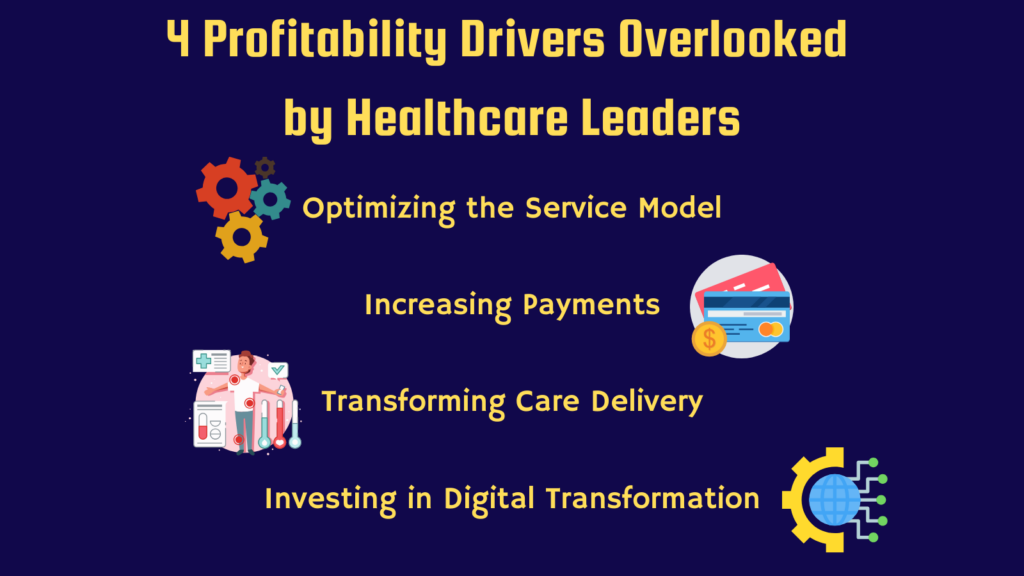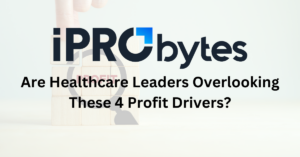(This article was originally published 10/24/23 and most recently updated 7/15/24)
In a recent Deloitte survey, over 60 healthcare CFO’s ranked 7 profit drivers. The top three profit drivers according to these CFO’s were:
- Improved revenue cycle
- Addressing talent issues
- Strengthening supply chains
Experts at The Deloitte Center for Health Solutions believe CFO’s are overlooking the other four profit drivers, which they believe may be more effective than the healthcare leaders’ top 3. Those four are:
- Optimizing the service model
- Increasing payments
- Transforming care delivery
- Investing in digital transformation

Let’s take a look at these four overlooked initiatives and how they can help drive healthcare profit.
Short on time? Watch the byte-sized version of this blog.

Optimizing the Service Model
Optimizing the service model was the 4th-ranked profit driver according to healthcare CFO’s, with 42 percent including it in their top 3 focuses. Optimizing the service model can drive profits in several ways. On one hand, streamlining workflows can optimize the workforce. For example, automating routine tasks can free up staff to focus more on patients or more complex tasks. This also helps to reduce errors, eliminating rework and reducing care delays. Ultimately, this all helps reduce labor costs by saving time.
Another way optimizing the service model can drive profit is by improving the patient experience. As staff spends more time with patients and the headache of care delays due to documentation errors is eliminated, patients are likely to have a better experience. This generates patient loyalty and can drive more business through positive reviews, word of mouth, and referrals.
Increasing Payments and Reimbursement
Tied at number 4 with optimizing the service model is “increased payments.” It goes without saying that collecting more money for services will boost profit. This is much easier said than done however, as providers face challenges collecting payments from both patients and payers.
Payments from Patients
When it comes to collecting payments from patients, providing a better patient financial experience, or PFX, goes a long way. Ways of improving the PFX include:
- Providing patients with estimated costs
- Offering financial assistance/counseling
- Electronic billing/payment via the patient portal or other online avenues
The key to collecting more payments from patients is removing barriers to payment. Patients are more likely to pay when it’s easier for them to do so.
Reimbursement from Payers
Another way to increase payments is to maximize reimbursements from payers, which account for as much as 75% of hospital revenues. The keys to minimizing claim denials and maximizing reimbursement are ensuring prior authorization requirements are met and that orders are accurate. While these tasks can be burdensome for clinical staff, they can be made easier.
By utilizing prior authorizations specialists that ensure proper documentation is submitted for orders and follow up with payers to ensure authorizations are approved in a timely manner, providers can streamline care and reimbursement. Technology such as referral order management software and clinical decision support (qCDSM) can ensure order accuracy and validation. Combining these solutions can help providers capture more reimbursement as well as improve throughput, driving even more profit.
For tips on improving your denials management process, read our blog on the topic.
Transforming Care Delivery
The 3rd profit driver healthcare leaders may be overlooking is care delivery transformation. In Deloitte’s survey, only 29% of healthcare CFO’s included this driver in their top 3 focuses. Care delivery transformation can greatly impact the patient experience, which, as we discussed earlier, can boost profits through patient loyalty and referrals. A recent Becker’s Healthcare article highlighted three keys to transforming care delivery:
- Improve patient access (self-scheduling, access to health data, etc.)
- Treat patients like consumers
- Engage patients beyond the exam room (text-based appointment reminders, follow-up surveys, etc.)
As healthcare disruptors continue to steal patients away from traditional healthcare providers, transforming care delivery becomes more important than ever. A strong patient engagement strategy is key to this. Enabling patients to easily and securely access their medical images without the use of CD’s can greatly improve patient engagement. Our CryptoChart solution replaces CD’s with a QR code that allows patients and providers to easily access and share medical images, reducing overhead and streamling care delivery.
Read our recent blog on how patient engagement can empower patients for more tips on transforming care delivery.
Investing in Digital Transformation
Investing in digital transformation is the most overlooked profit driver in Deloitte’s survey, with only 26% of healthcare CFO’s considering it a top-3 focus. Ironically, investing in digital transformation could be the backbone of many other profit drivers, including the three we previously discussed. Digital transformation has many forms, including:
- Artificial Intelligence (AI) and Machine Learning (ML) that automates routine tasks and provides fast insights
- Patient engagement tools such as SMS-based appointment reminders, navigation assistance, procedure prep instructions, electronic bill pay, and mobile access to health data
- Clinical decision support and order validation software to improve order accuracy and minimize claim denials
- Electronic order software that eliminates faxes and lost orders and converts unstructured data into structured data
Employing these technologies and others can streamline workflows, reduce burnout, improve care, capture more payments/reimbursement, and lead to a better healthcare experience for patients and providers alike.
We’re Here to Help Drive Your Profits
To recap, experts at Deloitte believe healthcare CFO’s may be overlooking these four profit drivers:
- Optimizing the service model
- Increasing payments
- Transforming care delivery, and
- Investing in digital transformation
At iPro, we offer solutions and support to help boost your bottom line. From our Novarad South brand’s innovative medical imaging solutions to 24/7 US-based support, we’ve got you covered. Contact us today to learn more about how we can help you realize your profit goals.




